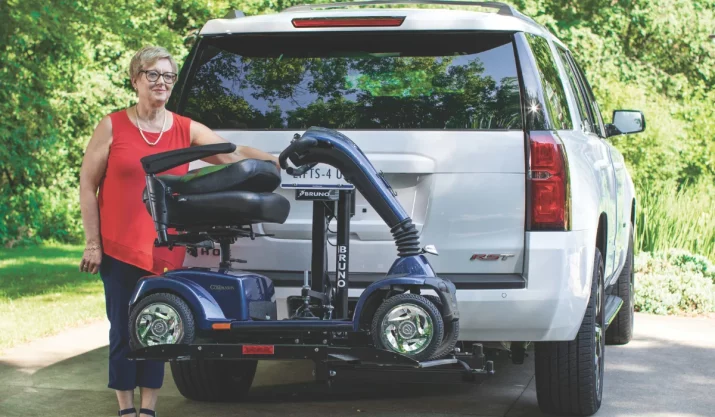My Mobility Scooter Has No Power and Won’t Start – Now What?

Table of Contents
Picture this: you’ve planned your day and plotted the spots you’d like to visit on your trusty mobility scooter. But suddenly, the unthinkable happens – your scooter won’t start. Hiccups like this can be worrisome, especially if your day-to-day mobility relies on your scooter. But fear not! This comprehensive guide will address the common issues that can hamper your scooter’s operation and how to troubleshoot them.
Key Takeaways
- The most common issues related to mobility scooter issues are motors, batteries, tires, the potentiometer, and the ignition switch.
- Adopting a safety-first approach while troubleshooting your mobility scooter is crucial.
- Gaining some basic hands-on knowledge can enhance your sense of independence and confidence in handling your scooter.
Common Scooter Problems and How to Fix Them
Your mobility scooter, whether a standard model or an e-scooter, is a sophisticated device with many different components. Each part plays a unique function, and understanding these components is essential for effective troubleshooting.
Motor Problems
The motor is akin to your scooter’s heartbeat, propelling it forward. However, when the motor encounters issues, your scooter may fail to kickstart or demonstrate decreased power.
Should you find your scooter resistant to kickstarting when you turn the key on, there might be a fault with the electric starter or the connectors. You can use a multimeter to test the starter motor’s condition to diagnose this. If the resistance (ohms) reading is infinite, it suggests that the starter motor isn’t functioning as it should. In such cases, you may need to replace it.
Don’t forget to check for damaged wires or loose connections, as they can interrupt the motor’s operation. If any are found, these should be repaired or replaced to restore your scooter’s functioning.
Battery Issues
The battery serves as the energy source for your e-scooter. When there are battery power issues, it can bring your mobility to a halt. If your scooter refuses to start or the headlight won’t switch on, it could signal a dead battery.
A voltmeter is a useful tool to verify your battery’s health. If the voltage reading is below the battery’s rated voltage (typically 12 volts for a standard battery), then your battery might be drained or defective, indicating it’s time for a recharge or even a new battery.
But before you rush out to buy a new battery, it’s also wise to check the charger. Sometimes, it’s not the battery at fault but the charger failing to deliver the appropriate output voltage.
Moreover, don’t forget to inspect for a blown fuse in your scooter’s circuit breaker – it’s a frequent culprit in power issues and can prevent the battery from charging. A visual inspection will reveal if the fuse is blown; replacing it should rectify the problem.
Tires
The tires form the foundation of your scooter’s mobility. Their health significantly influences the scooter’s overall performance. Over-inflated tires can cause your scooter to bounce around, making for an uncomfortable ride.
On the other hand, flat tires can make it difficult to move, even causing the scooter to refuse to start moving.
To fix tire-related issues, you should regularly inspect your tires for any signs of damage, like cracks or punctures. It’s also critical to check the tire pressure, ensuring it matches the manufacturer’s recommended PSI level. A handheld tire pressure gauge will help you do this accurately.
If your tire is flat, you must patch it up if the damage is minor. For major damage, a tire replacement may be necessary. In case of over-inflation, release some air until the pressure returns to the recommended level.
Remember, maintaining the proper tire pressure not only ensures a smoother ride but also prolongs the lifespan of your tires.
The Potentiometer
The potentiometer is crucial in regulating your scooter’s speed despite its small size. If it’s damaged or disconnected, it could be why your scooter refuses to start.
Fixing potentiometer issues typically involves inspecting any visible damage or disconnected wires. You can try reconnecting any loose wires, ensuring they are firmly connected. Be sure to check the potentiometer’s knobs and dials for any signs of damage or excessive wear as well.
However, if the potentiometer is damaged, it may require a replacement. In that case, you might want to consider getting a professional technician to replace it, as the process can be a bit complex and requires an understanding of electrical circuits.
Ignition System Problems
The ignition system, including the ignition switch (or key switch), is the primary starting point for your scooter. If the ignition switch is faulty, turning the key on might not start your scooter, even if your battery is fully charged.
Inspect the ignition system for any loose connectors or damaged wires to fix this. If you find any, try to secure the connectors and replace the damaged wires. In some cases, the problem could be with the key switch itself.
If worn out or damaged, the scooter may not register that the key has been inserted and turned. Replacing the key switch might be necessary in this case.
Remember, dealing with ignition systems can be complex. If you’re not confident, consider taking your scooter to a professional. It’s better to be safe than sorry, especially regarding electrical systems.
Fuel Issues
Fuel-related issues can be a common hurdle if you’re using a non-electric scooter, such as a 50cc model. The fuel system includes:
- The carburetor, which is the component that mixes fuel and air for combustion.
- The fuel line, which is responsible for transporting fuel from the tank to the carburetor.
- The fuel filter, which screens out debris and contaminants from the fuel.
In other words, if there’s a fuel supply issue, your scooter may fail to start. Regularly check these components for any blockages, leaks, or damage. For instance, a clogged fuel filter might restrict fuel flow, or a leaky fuel line might be starving your engine of the fuel it needs to run.
Adjusting the carburetor (“carb”) settings might be necessary for optimal performance for some scooters. This action typically involves setting the right mixture of air and fuel. It is generally recommended to be done by a professional to avoid further complications.
Other Common Issues
There are a couple of safety features on your scooter that, if not in their correct state, can prevent it from starting. The kill switch, for instance, is designed to cut off the engine for safety purposes. If it’s accidentally flipped to the “off” position, your scooter won’t start.
Also, some scooters have mechanisms that prevent the engine from starting unless the brake lever is engaged or the side stand is up. Before jumping to conclusions about major faults, check these components to ensure they’re in the correct position. It could be as simple as disengaging the kill switch, lifting the side stand, or engaging the brake lever to bring your scooter back to life.
Safety Precautions
Safety comes first while troubleshooting. Always turn the key off when checking electrical parts to avoid a short circuit. Wear safety gear, like glasses and gloves, and work in a well-lit, clean space.
Remember, it’s always better to seek professional help for repairs beyond your skill level. Understanding your mobility scooter’s components and troubleshooting common problems can save you stress and potentially expensive repair costs.
With some practice and patience, you’ll become adept at maintaining your scooter, giving you the peace of mind to enjoy your ride!








